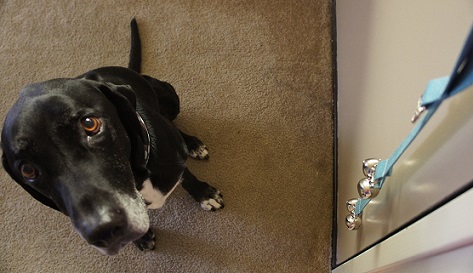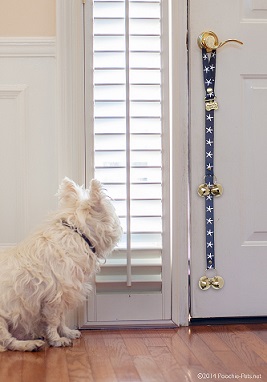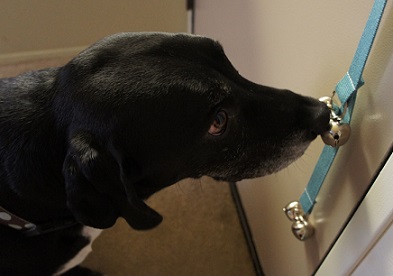I’ve been teaching my dog Ace to ring a bell when he needs to go outside to go potty.
It’s a fairly simple concept. If my dog needs to go outside, he would (ideally) tap the bells with his nose to alert me.
We are just starting our third week of training, so my dog is still learning, but I thought I’d share my tips on how you can use this bell training method for your own dog. If you’ve tried bell training, please share your experiences in the comments.
I am using a product called PoochieBells, made by Poochie-Pets, the sponsor of this post.
Why use bell training for your dog?

Using a bell can be a helpful communication tool between you and your dog.
Once the dog understands the concept, bell training solves a couple problems:
1. It gives your dog a clear way to tell you, “I gotta go.”
2. It is a more appropriate option for the dog than scratching at the door, whining or barking, which is what many dogs learn to do to get our attention. Others just sit at the door and wait quietly, but their owners don’t even notice.
How much time does it take for the dog to catch on?
Each dog is different, and a lot depends on the owner’s consistency in training and praise, according to Poochie-Pets, on its web site.
“Some dogs adapt to the behavior in a few days where others may take a few months.”
[quote_center]”Some dogs adapt to the behavior in a few days where others may take a few months.”[/quote_center]
Ace and I are on day 17, and he is just beginning to understand the concept. He understands to ring the bell on command – “Let’s go outside!” – but he’s just starting to understand that he can do so on his own without a command.
My dog is one of those super laid-back dogs who doesn’t want to bother anyone. Never in his life has he asked to go outside. While working on bell training, I’ve specifically been waiting longer between potty breaks, hoping this might motivate him to ask to go out.
Won’t my dog just ring that dang bell all the time?
I’m clearly not going to have this problem, but it’s a real concern for others.
Poochie-Pets addresses this on its web site. If your dog just went out and then rings the bell again right away, the company says you should wait a reasonable amount of time before responding to the ringing. A good rule is no more than once per hour. This will help the dog learn not to abuse his communication tool.
I would add that the owner should make sure the dog is getting adequate exercise, training and attention so he’s not simply bored. Of course, some dogs will continue to push the limits no matter what.
How to train a dog to ring a bell to go potty
I will explain the steps I’ve been following with Ace. We are staying pretty close to the training plan Poochie-Pets recommends. Please add your own suggestions in the comments. There are multiple ways to train a dog, and what works for one will not necessarily work for another.

1. Make sure your puppy is fully potty trained.
Don’t worry about bell training while you’re still potty training your puppy. That’s complicating things too much for the owner and the puppy.
Instead, focus only on training the puppy to go potty outside. Don’t expect your puppy to ask when she needs to go out at this point. Just take her out – often!
2. Hang up a bell.
You want to make sure the bell isn’t scary for your dog (too loud). It should also be safe just in case your dog chews on it.
PoochieBells are lead free, sturdy and won’t snag nails, according to Poochie-Pets.
You could hang the bell right on the doorknob, or hang it next to the door so it doesn’t annoy you every single time you come and go. Poochie-Pets sells cute hooks for this purpose. Using a hook may also help some dogs learn faster so they associate the bells only with potty breaks vs. people coming and going.

Make sure to hang the bell on the exact door you use for potty breaks. If you use multiple doors for potty breaks, stick to one door for now. This will make it easier for your dog to understand the concept.
3. Choose a command.
I use “Let’s go outside!” because that’s the phrase I’ve used for years. I added “ring!” at first, but then dropped it because I found it unnecessary. Use whatever you want. Just be consistent.
4. Ring the bell yourself.
For the first few potty breaks, just say the command and then ring the bells yourself. Say something upbeat like “Yay!” after you ring the bells, and then head outside with your dog. Do this for every potty break for a day or so.
5. Encourage your dog to ring the bells.
Use your command, and then point to the bells. You can even put a dab of peanut butter on them if you need to. When the dog even barely touches the bells, praise him and take him outside immediately as the reward.
Make sure you are able to reward your dog instantly when he rings the bell. Don’t waste time tying your shoes or looking in the mirror.

This step may take a few weeks, depending on the dog. (Ace and I are on day 17.)
Poochie-Pets does not recommend using treats, because getting outside should be the dog’s reward. That’s good advice. However, my dog is not very motivated to go outside, so I have been using treats, and this really helped. Every dog is different.
6. Be patient.
Don’t expect your dog to catch on right away. Ace still doesn’t ring the bell on his own until he sees me grab his leash or put on my shoes. That’s great! I reward him for that and get him out instantly. I want to make it positive and reward any small amount of progress he makes.
When he finally goes over and rings those bells on his own one of these days, I am prepared to act like he won the lottery. “Wooo! Yeah, Ace! What a good boy!”
Additional tips and potential problems
Don’t assume your dog understands what to do.
If your dog doesn’t ask to go outside, you should still take him out every five hours or whatever you know he needs. Just go through the bell-ringing process anyway. Say your command – “ring!” or “let’s go outside!” – get your dog to ring the bell, and then head out.
It’s more difficult if you live in an apartment.
We used to live in a townhome setting, and all I had to do was open the back door and the grass was right there. So convenient!
Now we live on the second floor of an apartment, which means to get to the “potty area” we have to walk down the hall, down the stairs, around the pool and through the parking lot.
This takes about 90 seconds, and I know my dog can’t make the association between the bell and getting to the grass. However, he can make the association (I believe) between the bell and getting me to open the door to “freedom.”
Where can I order a dog doorbell?

You can order the bells directly from Poochie-Pets here.
I also wrote a review on the product last week here, and the company gave away FREE PoochieBells to two lucky readers of That Mutt. *Congrats to LeeAnn and Debra.

Puppy Training Timeline By Age -
Wednesday 23rd of November 2022
[…] she isn’t in her kennel. Do not count on your pet to ask to go outdoors at this level or to ring a bell. Just take her […]
Puppy Training Timeline By Age - OrgBeTold
Sunday 6th of November 2022
[…] when she is not in her kennel. Do not expect your puppy to ask to go outside at this point or to ring a bell. Just take her […]
Pet Coaching Timeline Via Age - PET HOMEA
Wednesday 5th of October 2022
[…] in her kennel. Don’t be expecting your pet to invite to head outdoor at this level or to strike a chord. Simply take her […]
Puppy Training Timeline By Age - gopetcenter.com
Friday 11th of March 2022
[…] when she is not in her kennel. Do not expect your puppy to ask to go outside at this point or to ring a bell. Just take her […]
Jo
Saturday 6th of August 2016
I have a dilemma. My dog is Bell trained quite well for my house but when we go anywhere else or to visit someone, he doesn't know how to bark to go outside. What do you suggest for this?